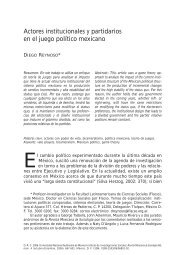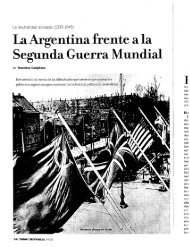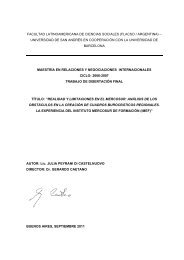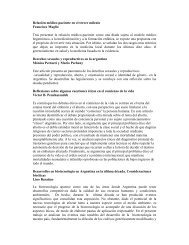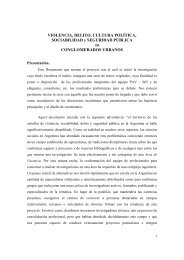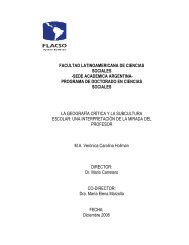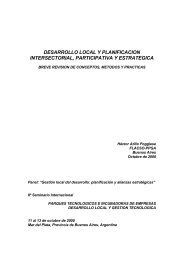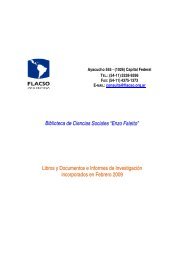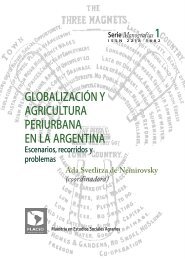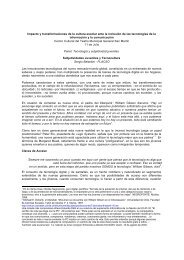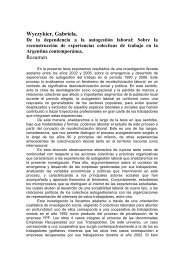Mercedes Botto Andrea Carla Bianculli - Flacso
Mercedes Botto Andrea Carla Bianculli - Flacso
Mercedes Botto Andrea Carla Bianculli - Flacso
Create successful ePaper yourself
Turn your PDF publications into a flip-book with our unique Google optimized e-Paper software.
allowing for the recovery of the trade flows that existed before the debt crisis, the PICE was<br />
intended to reduce the trade disequilibria through, among other means, trade liberalization, greater<br />
economic complementation, and technological cooperation [INTAL, 1998].<br />
The idea of sectoral integration addressed thus two fundamental questions. On the one hand, it<br />
reflected a concern with planning and consolidating the industrial process, and, on the other, the<br />
emphasis on achieving balanced trade through sectoral agreements was intended to attenuate the<br />
fears of Argentine and Brazilian businesses regarding possible losses and diffuse political opposition<br />
to deeper integration [Valls Pereira, 1999]. In terms of the motivations underlying business sectors’<br />
interest in participating within this process, it is clear that those sectors that feared possible losses,<br />
assumed their participation as a way of ensuring their own exclusion from the final lists of<br />
products.<br />
The decision-making process on regional integration remained largely top-down, state-led, and<br />
highly dependent on presidential initiatives: the PICE was the result of the deliberations carried out<br />
mainly within the Ministry of Economy, with limited or no input from the Ministry of Foreign<br />
Affairs. Certainly, this change in the liberalization process, which would be now carried out on a<br />
regional integration basis, entailed a new challenge for the government. What role, if any, was<br />
ascribed to research and academia?<br />
Technical expertise was provided by certain research centres, but these would only become<br />
involved once the PICE was already negotiated and settled: given that their participation would be<br />
circumscribed to the implementation phase, technicians and experts did not play an influencing role<br />
on the design and negotiation of this founding agreement. This same pattern could be applied to<br />
the participation of business sectors.<br />
Even if the text of the PICE contained interesting provisions on the role of the private sector in the<br />
integration process, this was mainly circumscribed to the implementation phase as well [Gardini,<br />
2006]. The negotiation of the sectoral agreements between Brazil and Argentina was structured as a<br />
process of negotiated liberalization, while clearly avoiding a divergence in the terms of interchange.<br />
Government officials decided which sectors would be included in the PICE, and then, asked<br />
business associations in these sectors to work out agreements with their counterparts in Brazil<br />
[Schneider, 2004].<br />
Overall, however, the PICE remained reminiscent of old regionalism, mainly in terms of the<br />
participation scheme, which assumed the same pattern as that of the LAIA: interchange of<br />
concessions on products with limited domestic production, and the emergence of difficulties or<br />
conflicts when advancing on sensitive products [Bouzas and Soltz, 2005].<br />
This integration pattern presents thus two main characteristics. First, it was a cautious approach to<br />
liberalization by means of regional integration, which responded to an ideology of industrial<br />
promotion and protection, and to a state-led trade liberalization process. Secondly, it clearly<br />
reflected the prevailing rhetoric of democracy, which claimed that civil society participation was<br />
12




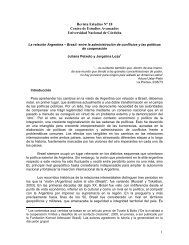
![[P] Disertacion.Melisa.Galvano.pdf - Flacso](https://img.yumpu.com/14596629/1/184x260/p-disertacionmelisagalvanopdf-flacso.jpg?quality=85)
